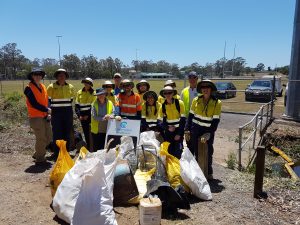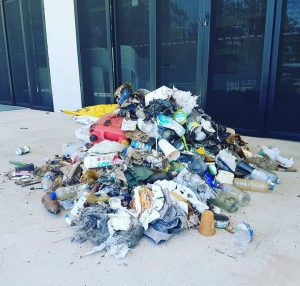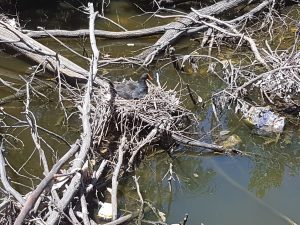A while ago I had the privilege of being invited to talk to all the office staff in the Veolia Offices in Brisbane. The day was successful and their environment team talked about working with us in the future. Well that came to fruition last Thursday when Veolia sponsored a day with Conservation Volunteers Australia and the Green Army. They invited us along on the day so we could organise and run a clean up along the estuary where they were to run a planting afternoon.
 So with excitement I turned up at the RJ Frawley football ground in Silcock St, Clontarf. I met with the CVA and Green Army team and also Carlos from Veolia, their environmental manager. A few members of the Redcliffe Environmental Forum also attended so it was a good group. After a few briefings a team of 14 headed off along an estuary that leads into Hays Inlet, one of Brisbane’s most important fish breeding grounds. This estuary basically has two drainage systems leading into it from the main road (Elizabeth Ave). They join half way to the water and we decided to clean up along the end part. With more time and/or more people, we could have cleaned up the two lead in areas, but that is another story. I will get to the state of those areas later.
So with excitement I turned up at the RJ Frawley football ground in Silcock St, Clontarf. I met with the CVA and Green Army team and also Carlos from Veolia, their environmental manager. A few members of the Redcliffe Environmental Forum also attended so it was a good group. After a few briefings a team of 14 headed off along an estuary that leads into Hays Inlet, one of Brisbane’s most important fish breeding grounds. This estuary basically has two drainage systems leading into it from the main road (Elizabeth Ave). They join half way to the water and we decided to clean up along the end part. With more time and/or more people, we could have cleaned up the two lead in areas, but that is another story. I will get to the state of those areas later.
We headed out with our bags and gloves and the team did an amazing job. The crew from the Green Army are all people who work 4 x 8 hour days a week. The project is federally funded and the team were very passionate about their environment. After 5 minutes of collecting items I had to ask the team where the nearest McDonalds was? They all started dreaming of smoothies as it was a very hot day, but the reason I asked was that I knew it had to be close, I kept finding straws and other containers. By the end of the day we had found a total of 79 items that could be lead back to McDonalds. The closest outlet was at the top of one of the estuaries.
Another thing we kept finding was polystyrene in numbers that was a bit unusual. Someone pointed out that there was a door supplier in the adjoining street and they had bins full of polystyrene packing. So another source. One of the reasons we sort through the data is for this very reason. If we just pick up debris, then that is all we will ever do. We need to sort it and the data we get is used for source reduction. Just these two sources that we have identified gives us data to take to those companies so recently I spoke with Anita Christian from Moreton Bay Regional Council. She is the Waste Minimisation Officer so in early December we will visit these businesses and talk to them about ways to reduce the amount of rubbish coming from them.
 After 90 minutes of cleaning up we had 15 large bags and several large items. After a quick snack some of the team helped me sort through the debris. Below is a list of some of the numbers of items found
After 90 minutes of cleaning up we had 15 large bags and several large items. After a quick snack some of the team helped me sort through the debris. Below is a list of some of the numbers of items found
- 46 pieces of McDonalds packaging
- 33 Drinking Straws
- 106 pieces of polystyrene foam
- 149 Plastic Water Bottles
- 2200 pieces of plastic remnants (Packaging and wrappers that were less than 50% their original size
- 720 pieces of hard plastic
- 39 Aluminium Cans
- 31 glass bottles
- 3 Batteries
- 1 fuel can
A total of 3,500 pieces of debris were removed weighing 122kg.
 As mentioned earlier, the drains that lead into the estuary we cleaned come from Elizabeth Ave. They were filthy. We really need a day in each drain to pull out the amount of debris that is there. On a tree that had fallen, a black bird had created a nest that had 4 eggs in it. The tree was acting like garbage catchment area so it was surrounded in debris. The debris comes from the main roads, washing down the drains when it rains. With the fish breeding sanctuary at the end of the estuary, it is really important we find a solution to stop this. The locals tell me that with good rain the rubbish doesn’t even follow the drainage system, it just goes up and over the embankment and into a lagoon so we will work with MBRC to find a solution to this problem. Catching it at the top of the drainage system seems to be the most likely solution.
As mentioned earlier, the drains that lead into the estuary we cleaned come from Elizabeth Ave. They were filthy. We really need a day in each drain to pull out the amount of debris that is there. On a tree that had fallen, a black bird had created a nest that had 4 eggs in it. The tree was acting like garbage catchment area so it was surrounded in debris. The debris comes from the main roads, washing down the drains when it rains. With the fish breeding sanctuary at the end of the estuary, it is really important we find a solution to stop this. The locals tell me that with good rain the rubbish doesn’t even follow the drainage system, it just goes up and over the embankment and into a lagoon so we will work with MBRC to find a solution to this problem. Catching it at the top of the drainage system seems to be the most likely solution.
This day was thanks to Veolia. Without their donation to CVA, we couldn’t have put this day on.